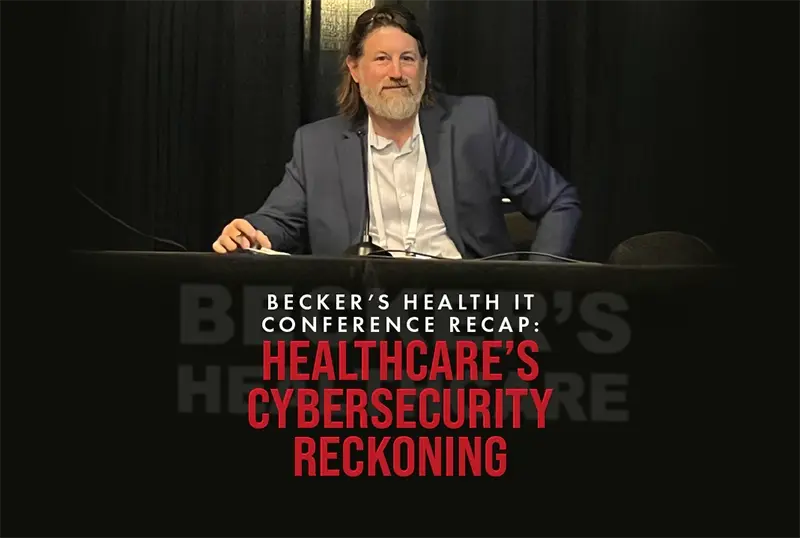At Becker’s HealthCare 10th Annual Health IT + Digital Health + RCM Conference, healthcare leaders confronted a sobering truth: cybersecurity is no longer a back-office IT issue, it’s a boardroom-level business survival challenge. The conversations across panels and keynotes were unified by one message: traditional security models are no longer keeping pace with the speed, scale, and sophistication of today’s threats.
The State of Healthcare Cybersecurity: An Industry in Crisis
2024 was a watershed year for healthcare cyber incidents.
More than 276 million patient records were compromised, equivalent to 81% of the U.S. population. Ransomware attacks struck two-thirds of healthcare organizations, nearly double the rate from just three years prior.
And the downstream effects are devastating. A revenue-cycle leader described walking into a new job only to find every system down by day two:
“The CFO came in and said, ‘I’ve got two payrolls worth of cash. We’ve got to act now.’”
Even when systems come back online, recovery drags on for 18–24 months. Claims reconciliation, appeals, and patient confusion can cripple operations long after systems are restored.
Change Healthcare: The Breach That Changed Everything
The Change Healthcare incident was a wake-up call of historic proportions. Affecting 190 million individuals, it revealed the dangers of over-centralization in healthcare’s digital infrastructure. When one vendor processes 15 billion transactions a year and touches 1 in 3 patient records, a single breach can ripple across the entire system.
The fallout was staggering:
- 94% of hospitals reported financial impact.
- 33% saw disruption to over half their revenue.
- 60% required weeks or months to return to normal operations.
And the entry point? A compromised credential on a portal without multifactor authentication. A simple, preventable lapse with industry-wide consequences.
Third-Party Risk: The Achilles’ Heel of Healthcare
Healthcare’s digital ecosystem has become a tangled web of vendors. Some large systems now manage 700+ third-party connections, each a potential attack vector.
Panelists shared a disturbing realization from the Change Healthcare fallout: “Your backup vendor might be using the same backend as your primary.” Redundancy turned out to be an illusion.
Traditional certifications like HITRUST, SOC, or ISO provide compliance comfort but not real-time protection.
As one CISO put it bluntly: “Change Healthcare had every certification in the book and look what happened.”
The future must involve continuous monitoring of vendor behavior, not just annual audits and questionnaires.
Staffing Shortages and Surging Complexity
CISOs across the conference acknowledged an uncomfortable truth: the industry cannot hire its way out of this crisis.
Healthcare IT teams are stretched thin, managing sprawling, interconnected systems and legacy applications that can’t be easily updated. Remote work has widened the attack surface, while even well-trained staff experience “muscle memory amnesia” when incidents strike.
The consensus was clear: solutions must work automatically, at scale, without requiring 24/7 human oversight. Manual response models are collapsing under the weight of modern threat velocity.
AI: The New Offensive Weapon
Artificial intelligence has tilted the battlefield.
By early 2025, deepfake and AI-driven social engineering incidents had already surpassed all of 2024’s total. Attackers now use voice cloning to impersonate executives, AI-optimized ransomware to target critical systems, and adaptive malware that rewrites itself to bypass endpoint detection.
One CMIO quipped that tools which once took “15 years to develop can now be built in an afternoon.” Yet only 29% of healthcare executives say they feel prepared for AI-powered attacks.
As one panelist observed: “These threat actors have strategic plans. They’re funded. They’re organized. And they’re laughing because they’ve groomed your organization.”
From Defense to Resilience: What Works in the Real World
Organizations that survived large-scale cyber incidents offered practical wisdom forged in crisis:
- Act immediately and don’t waste the crisis. Use downtime to modernize. One organization completed an accelerated RFP during the Change Healthcare outage, from signature to go-live in 25 days and cut costs by 75%.
- Plan for long-term outages. Build clinical continuity procedures by department, assuming 30+ days of disruption.
- Make cybersecurity everyone’s responsibility. Department heads must own their risk, and vendors should be included in tabletop exercises.
- Demand solutions that deliver instant protection. Defenses must be operational in hours or days, not quarters.
- Monitor behavior, not credentials. Real-time monitoring exposes anomalies certifications can’t.
- Share intelligence. A threat detected by one organization should protect all.
The Path Forward: Automation and Perimeter Protection
The call to action from Becker’s was unmistakable: healthcare needs automated, perimeter-focused defenses that work faster than attackers move.
Complex, manually tuned security stacks are no longer sustainable. The future lies in automated network-edge protection that blocks threats in real time, reduces dependency on overworked staff, and continuously monitors vendor and third-party activity.
As one compliance officer said: “We have to stop being surprised. Our defenses need to work before we’re forced to invoke our business continuity plans.”
With ransomware recovery times exceeding a month for more than one-third of organizations, average breach costs topping $9.8 million, and two-thirds of backups compromised in attacks, proactive perimeter protection isn’t optional, it’s existential.
A New Mindset for Healthcare Security
The overarching message from Becker’s was as urgent as it was unified: Healthcare must stop reacting and start anticipating.
Organizations that embrace automation, continuous visibility, and community threat intelligence will weather the next wave. Those that don’t will find themselves reliving the Change Healthcare crisis, again and again.
No-Cost Data Breach Defense Program
Celerium helps healthcare organizations defend their digital front lines with automated, near real-time protection and community threat intelligence solutions designed to empower overburdened IT teams. For a limited time, try Data Breach Defender™ at no cost to you and see our solution in action. Deployment is fast, less than 30 minutes, requires little to no maintenance and offers 24/7365 protection, reporting and more.
Start here to participate in this No-Cost Data Breach Defense Program. By participating, organizations gain an additional layer of defense against data breaches.

